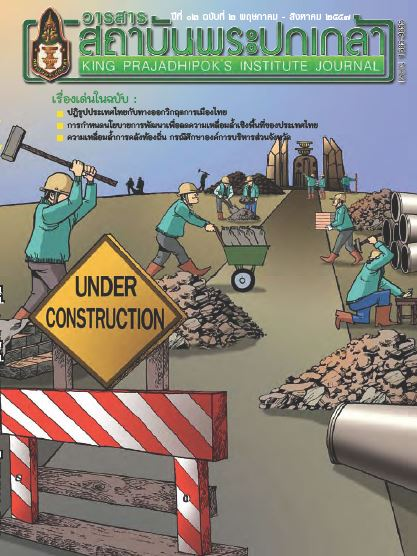Guidelines for Flood Management : case study from Nonthaburi Municipality
Main Article Content
Abstract
In 2011 Thailand experienced “the Mega-Flood,” which caused serious damage and has already become a noted part of the country’s history. In that incident, local governments, as the main actors in providing public services, participated in resolving the problem, especially in Nonthaburi Municipality, which is in charge of the area in the end zone of water management, where water passes just before draining into the Gulf of
Thailand. Nonthaburi Municipality had to take care of an area that included over 10 kilometers of the Chaophraya River’s banks. In addition, it had to take care of Bang Talad Canal, Suay Canal, and Bang Khen Canal, which are 15.7 kilometers in length in total. With that geography, the flood management was very challenging, but Nonthaburi Municipality was able to save the city. This study has three objectives: firstly, to explore
factors affecting the achievements in flood management of Nonthaburi Municipality; secondly, to explore problems and obstacles in flood management in Nonthaburi Municipality; finally, to suggest some guidelines for sustainable flood management for local governments. Information was gathered through documentary research, in-depth interviews, and focus group discussions with the executives/ officers of Nonthaburi
Municipality, members of the Municipality Council, representatives of the people, and private organizations that participated in the flood management efforts of local authorities.
This study revealed several achievements in flood management of Nonthaburi Municipality. The first factor was having a protection and mitigation plan that was developed via risk evaluation and promotion of understanding and awareness of protecting and mitigating the disaster. Second, was the readiness of Nonthaburi Municipality and of its people, their ability to dwell in the basin area of Chaophraya River basin area, having of flood management plan, and preparation of officers for handling flooding. Third, having of management system for emergency situations like floods, crisis management, promoting collaboration for flood management, communication system in time of crisis, establishing of command center and sanctuary for victims. And fourth, having appropriate post-crisis management, treatment and care, and compensation for
victims. The problems and obstacles in flood management of Nonthaburi Municipality were, firstly, the limitations of laws related to procurement. During the incident, Nonthaburi Municipality could not comply with the laws. Secondly, problems in garbage collection, if handled inappropriately, could cause refuse to accumulate then magnified to be a health problem for the community in the long run. Thirdly, there was a lack of
instruments and manpower in time of crisis. As a result, there was discord over the allocation of sandbags. Fourthly, the flood barriers leaked continuously. Fifthly, there was a problem concerning safety of lives and property, with people concerned enough about their belongings that they were willing to put their lives at risk. And lastly, there were problems in delivering compensation.
The suggestions for sustainable flood management of local governments were, first, to have planning of flood management, flood prevention and mitigation, preparation for flood management, management for crisis situations (flooding), post-disaster management. Second, leadership in time of crisis could help decision making. Third, there should be collaboration-building with a variety of sectors involved in flood management. Fourth, a sanctuary area should be prepared. Moreover, there were three remarks arising from this study. First, the study advocates the idea of expanding localism for handling difficult problems as much as possible. Second, politicians have a responsibility to their people. Third, local areas should be professionally managed. And last, there should be networking in local administrations.
Article Details
@ 2020 King Prajadhipok's Institute The Government Complex Commemorating All Right Reserved.
References
คณะกรรมการป้องกันและบรรเทาสาธารณภัยแห่งชาติ. ๒๕๕๒. แผนการป้องกันและบรรเทาสาธารณภัยแห่งชาติ พ.ศ. ๒๕๕๓-๒๕๕๗. กรุงเทพฯ: กรมป้องกันบรรเทาสาธารณภัย กระทรวงมหาดไทย.
ทวิดา กมลเวชช. ๒๕๕๔. คู่มือการจัดการภัยพิบัติท้องถิ่น. กรุงเทพฯ: วิทยาลัยพัฒนาการปกครองท้องถิ่น สถาบันพระปกเกล้า.
ไททัศน์ มาลา สุนทรชัย ชอบยศ และพิศาล พรหมพิทักษ์กุล. ๒๕๕๖. แนวทางในการจัดการอุทกภัย: กรณีศึกษาเทศบาลนครนนทบุรี. รายงานการวิจัย เสนอต่อสำนักงานกองทุนสนับสนุนการวิจัย (สกว.).
พระราชบัญญัติป้องกันและบรรเทาสาธารณภัย พ.ศ. ๒๕๕๐. ราชกิจจานุเบกษา. เล่ม ๑๒๔ ตอนที่ ๕๒ ก วันที่ ๗ กันยายน ๒๕๕๐.
รัฐธรรมนูญแห่งราชอาณาจักรไทย พ.ศ. ๒๕๕๐. ประกาศในราชกิจจานุเบกษา เล่ม ๑๒๔ ตอนที่ ๔๗ ก หน้า ๑ ๒๔ สิงหาคม ๒๕๕๐.
หัสยา ไทยานนท์. ๒๕๕๕. แนวทางการบริหารจัดการภัยพิบัติของชาติอย่างยั่งยืน. กรุงเทพฯ: ศูนย์ศึกษายุทธศาสตร์ สถาบันวิชาการป้องกันประเทศ.
Alexander, David. 2002. Principle of Emergency Planning and Management. New York : Oxford University Press.
Canton, Lucien G. 2007. Emergency Management Concept and Strategies for Effective Programs. Hoboken. N.J. : Wiley-Interscience.
Carter, W. Nick. 1992. Disaster management : a disaster manager’s handbook. Manila, Philippines : Asian Development Bank.
Coppola, P. Damon. 2007. Introduction to international disaster management. Amsterdam. Boston : Butterworth Heinemann.
Daniel Henstra. 2010. Evaluating Local Government Emergency Management Programs: What Framework Should Public Managers Adopt?. In Public Administration Review. March - April . pp 236-246.
Phillips; Neal and Webb. 2012. Introduction to Emergency Management. United State of America : CRC Press.

